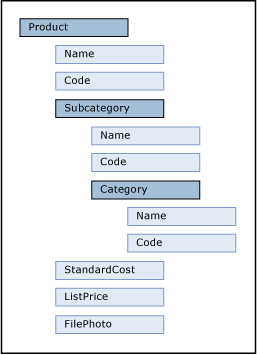Attributes (Master Data Services)
Attributes are objects that are contained in Master Data Services entities. Attribute values describe the members of the entity. An attribute can be used to describe a leaf member, a consolidated member, or a collection.
How Attributes Relate to Other Model Objects
You can think of an attribute as a column in an entity table. An attribute value is the value used to describe a specific member.

When you create an entity that contains many attributes, you can organize the attributes into attribute groups. For more information, see Attribute Groups (Master Data Services).
Required Attributes
When you create an entity, the Name and Code attributes are automatically created. Code requires a value and must be unique within the entity. You cannot remove the Name and Code attributes.
Attribute Types
There are three types of attributes:
Free-form attributes, which allow free-form input for text, numbers, dates, or links.
Domain-based attributes, which are populated by entities. For more information, see Domain-Based Attributes (Master Data Services).
File attributes, which are used to store files, documents, or images. File attributes are intended to help with the consistency of your data by requiring files to have a specific extension. File attributes cannot be guaranteed to prevent a malicious user from uploading a file of a different type.
Numeric Free-Form Attributes
Numeric free-form attributes require special handling, because numeric free-form attribute values are limited to the SqlDouble value type.
By default, a SqlDouble value contains 15 decimal digits of precision, although a maximum of 17 digits is maintained internally. The precision of a floating-point number has several consequences:
Two floating-point numbers that appear equal for a particular precision might not compare equal because their least significant digits are different.
A mathematical or comparison operation that uses a floating-point number might not yield the same result if a decimal number is used because the floating-point number might not exactly approximate the decimal number.
A value might not roundtrip if a floating-point number is involved. A value is said to roundtrip if an operation converts an original floating-point number to another form, an inverse operation transforms the converted form back to a floating-point number, and the final floating-point number is equal to the original floating-point number. The roundtrip might fail because one or more least significant digits are lost or changed in a conversion.
Attribute Examples
In the following example, the entity has the attributes: Name, Code, Subcategory, StandardCost, ListPrice, and FilePhoto. These attributes describe the members. Each member is represented by a single row of attribute values.

In the following example, the Product entity contains:
The free-form attributes of Name, Code, StandardCost and ListPrice.
The domain-based attribute of Subcategory.
The file attribute of FilePhoto.
Subcategory is an entity that is used as a domain-based attribute of Product. Category is an entity that is used as a domain-based attribute of Subcategory. Like the Product entity, the Category and Subcategory entities each contain the default Name and Code attributes.

Related Tasks
| Task Description | Topic |
|---|---|
| Create a new free-form text attribute. | Create a Text Attribute (Master Data Services) |
| Create a new free-form numeric attribute. | Create a Numeric Attribute (Master Data Services) |
| Create a new free-form link attribute. | Create a Link Attribute (Master Data Services) |
| Create a new file attribute. | Create a File Attribute (Master Data Services) |
| Create a new domain-based attribute. | Create a Domain-Based Attribute (Master Data Services) |
| Change the name of an existing attribute. | Change an Attribute Name (Master Data Services) |
| Add existing attributes to a change tracking group. | Add Attributes to a Change Tracking Group (Master Data Services) |
| Delete an existing attribute. | Delete an Attribute (Master Data Services) |
| Change the order of attributes. | Change the Order of Attributes |